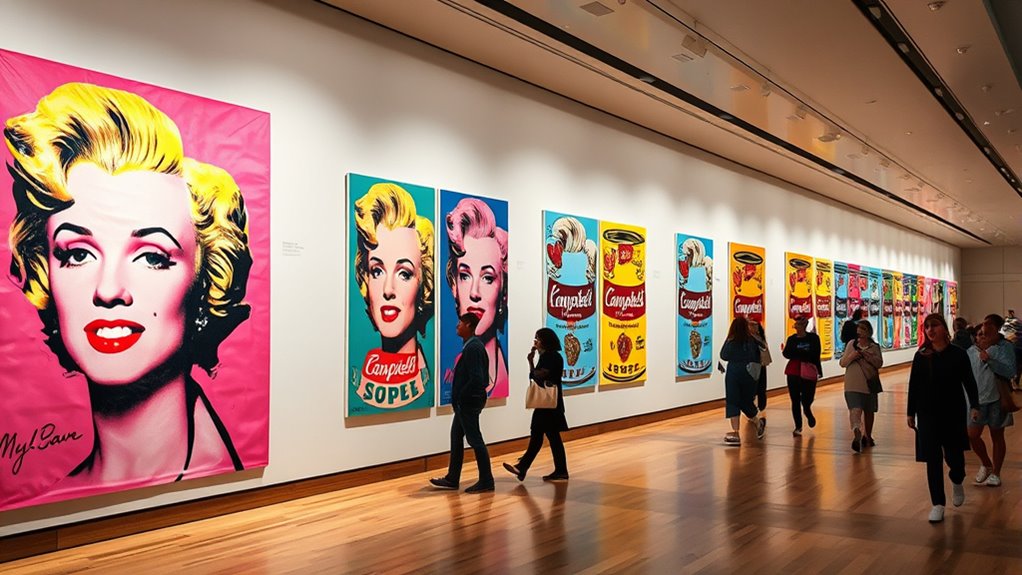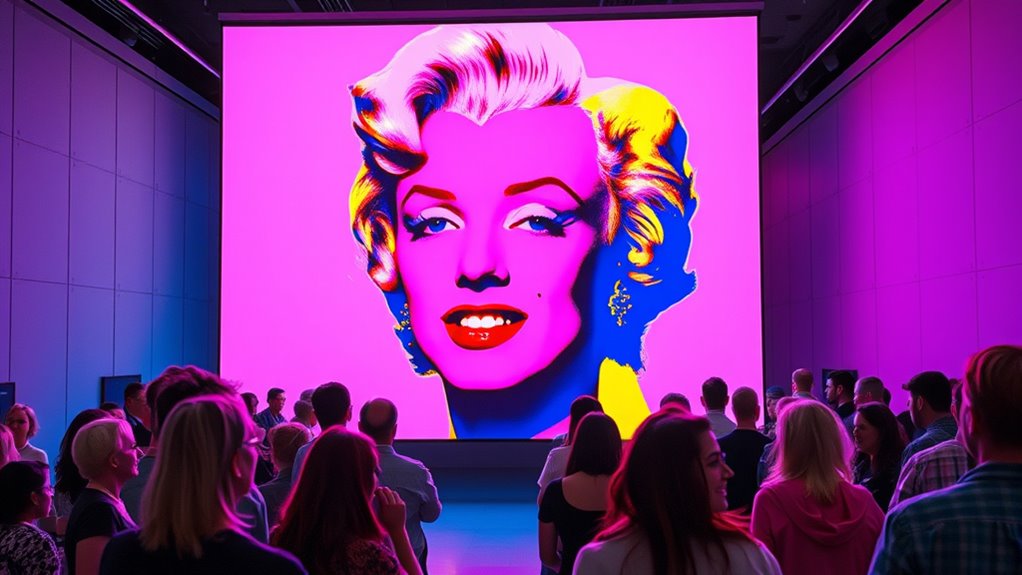Andy Warhol revolutionized mass culture by turning everyday images into iconic art, blending high art with commercial imagery. His silkscreen technique emphasized reproduction, making art more accessible and reflective of media saturation. Warhol’s focus on celebrities and consumerism showed how media shapes societal ideals and identity. His work highlights society’s obsession with fame and mass production. Staying engaged will reveal how his ideas still influence contemporary art and culture today.
Key Takeaways
- Warhol pioneered silkscreen printing, emphasizing mass reproduction and blurring distinctions between fine art and commercial imagery.
- His artworks reflected media saturation, making art more accessible and mirroring consumer culture and societal aesthetics.
- By portraying celebrities repeatedly, Warhol elevated fame to an artistic and mythic status, critiquing society’s obsession with celebrity as commodity.
- His focus on media and advertising highlighted their role in shaping public perception and amplifying celebrity images.
- Warhol’s integration of modern technology and digital media demonstrates his enduring influence on contemporary art and mass culture.

Andy Warhol was a pioneering American artist who revolutionized the world of visual culture with his innovative approach to art and mass media. His work blurred the lines between fine art and commercial imagery, transforming everyday objects and celebrities into icons. One of his most groundbreaking techniques was silkscreen printing, which allowed him to produce multiple copies of the same image quickly and consistently. This method became fundamental to his art, emphasizing reproduction and mass production, echoing the very essence of consumer culture. By using silkscreen techniques, you can see how Warhol challenged traditional notions of originality, making art accessible and reflective of a world saturated with images. His focus on reproduction underscored how media and consumerism shaped modern society’s aesthetic values. Additionally, Warhol’s art exemplifies the impact of mass culture on individual identity and societal values, illustrating how popular images influence collective consciousness. Furthermore, Warhol’s use of repetition and serial imagery reflected the mechanization of modern life and the pervasive influence of technology on art and culture. His exploration of media saturation highlighted how media channels and advertising amplify the reach of celebrity images, shaping public perception and societal norms. The rise of AI-driven image generation and digital media continues to influence how artists and audiences interact with celebrity images today, echoing Warhol’s fascination with fame. Warhol’s fascination with celebrity influence played a vital role in his artistic identity. He believed that fame itself was a form of art, and he capitalized on this idea by portraying celebrities like Marilyn Monroe, Elvis Presley, and Elizabeth Taylor repeatedly. When you look at his work, you notice how he elevates these figures to a mythic status, turning them into household icons. His repeated images mirror the way media and advertising amplify celebrity culture, reinforcing its omnipresence. Warhol understood that in a society obsessed with fame, the celebrity image had become a commodity, and he used his art to comment on this obsession. His silkscreen prints of famous personalities were not just portraits; they were social commentaries on fame, consumerism, and the mass media’s power to shape public perception.
Frequently Asked Questions
How Did Warhol Influence Modern Digital Art?
You see, Warhol’s influence on modern digital art is profound. He pioneered digital aesthetics by blurring lines between commercial and fine art, inspiring artists to experiment with technology. His approach to mass production and celebrity culture now fuels interactive art projects, where viewers engage directly. Warhol’s legacy encourages you to embrace digital tools, creating dynamic, participatory pieces that reflect contemporary culture and redefine how art interacts with audiences.
What Were Warhol’S Favorite Subjects Beyond Celebrity Culture?
Did you know Warhol created over 300 screen prints of everyday objects? Beyond celebrity culture, he was fascinated by mundane items like soup cans, bottles, and dollar bills. You see, Warhol blurred the lines between high art and mass production, drawing inspiration from abstract expressionism but focusing on ordinary subjects. His work challenges you to see beauty in the commonplace, reflecting society’s obsession with consumer culture and everyday life.
Did Warhol’s Work Face Any Major Censorship Issues?
You might wonder if Warhol’s work faced censorship controversies. While he challenged societal norms with bold, provocative art, he didn’t encounter major censorship issues like some artists did. His work was generally well-received by the public, though it sparked debates about commercialization and authenticity. Warhol’s approach to mass culture kept him at the forefront, and his art’s public reception remained largely positive, cementing his influence rather than facing significant censorship hurdles.
How Did Warhol’S Personal Life Affect His Art?
Your question about how Warhol’s personal life affected his art highlights his personal struggles and artistic inspiration. You might notice that his struggles with identity and fame fueled his fascination with celebrity culture and consumerism. Warhol’s experiences with illness and loss also inspired some of his darker, more introspective works. His personal life deeply influenced his art, making it a reflection of his inner world and societal observations.
What Was Warhol’S Impact on Advertising and Commercial Design?
Imagine a world where art and advertising collide—Andy Warhol made that happen. His work revolutionized branding strategies, blending art with commercial appeal. You see his influence in how products are marketed today, capturing consumer engagement through bold visuals and mass production techniques. Warhol turned everyday objects into iconic symbols, proving that art can fuel commercial success and shape consumer culture. His impact is a lasting evidence to creative innovation in advertising.
Conclusion
You see, Andy Warhol’s influence on pop art transformed how you view mass culture, making everyday objects iconic. His work blurred the lines between high art and commercialism, much like how today’s social media blurs reality and fantasy. Just as you scroll through endless feeds, Warhol’s art invites you to rethink what’s valuable. So, next time you see a Campbell’s Soup can, remember—you’re actually witnessing a 1960s revolution that’s still shaping your world today.









